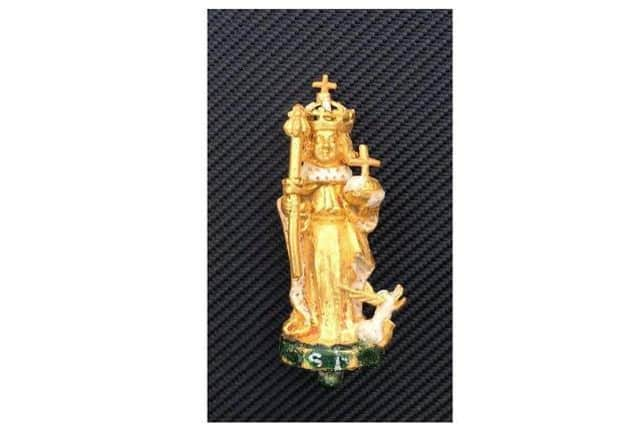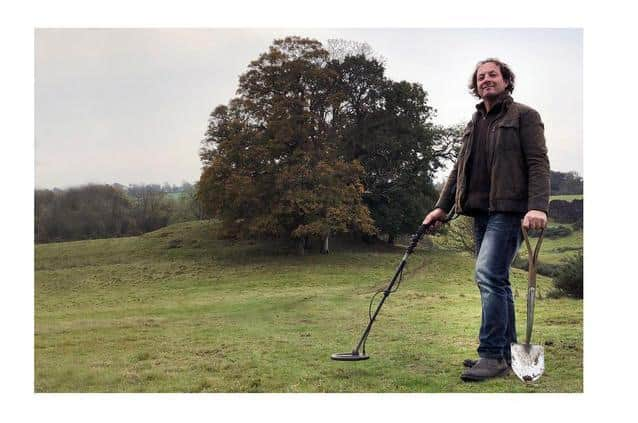'Striking gold has changed turned my life upside down' says amateur treasure hunter after his 'one in a million' find near Harborough


Back in January 2021, we reported about Kev Duckett's amazing 'one in 10 million' find when he found gold centrepiece of King Henry VIII’s long-lost crown on the edge of Market Harborough. Two months on, we spoke to the amateur treasure hunter to see how the find has changed his life.
Brilliant amateur treasure hunter Kev Duckett made international headlines after he found the stunning solid gold centrepiece of King Henry VIII’s long-lost crown on the edge of Market Harborough.
Advertisement
Advertisement
Amazed Kev, 50, made his incredible “one in 10 million” find under a tree in a field at the back of Market Harborough Golf Club by the deserted medieval village of Little Oxendon.


And he has been working non-stop carrying out meticulous research into the priceless 1.4ins-high 24ct gold enamelled figurine showing King Henry VI as a saint after the staggering story emerged in January 2021.
Kev, of Fleckney, told the Harborough Mail: “I am totally devoted to finding out as much as I can about this beautiful crown, its historical background and how it came to end up in the countryside near Market Harborough.
“It is an astonishing saga with King Henry VIII right at the heart of it stretching back over 500 years.
Advertisement
Advertisement
“I am determined to find out as much as I can about this extraordinary royal mystery right here on our very doorsteps.
“Finding this exquisite jewel has turned my life upside down – and even taken it over in some ways,” said Kev, a dedicated detectorist for over 30 years who made his seminal discovery in September 2017.
“I’ve put in some time every day for at least the last year to try to discover far more about this unique figure.
“I’ve been reading book after book to try to piece together this jigsaw.
Advertisement
Advertisement
“The information and the resources are out there but no one has been looking for it or putting in the legwork and the hard yards,” said Kev, a classic car restorer.
“I’ll carry on doing all the detective work but I’m not sure where it will all end.
“This truly is a huge labour of love for me.”
He has been trawling through a mini-mountain of royal inventories as well as firing off hundreds of emails to academics, historians, researchers and experts all over the country.
“There’s a stack more information out there and tons and tons of inventories from that time and contemporary documents.
“They are just piled up in our museums.
Advertisement
Advertisement
“I just wish I had far more time to explore all the many different material sources,” said Kev.
The coronation crown was originally decorated with three figures of Christ, one of St George and one of the Virgin and Child.
But Henry VIII removed the figures of Christ and replaced them with three saint kings of England - St Edmund, Edward the Confessor and Henry VI.
The iconic king wore the crown at his 1509 coronation and when he married Anne of Cleves, the fourth of his six wives, in 1540.
Advertisement
Advertisement
“The gold content of the jewel gives clues as to what it was designed for.
“Pure gold hasn't been mixed with any other metals.
“The jewel is 98 per cent gold which is extremely unusual,” said Kev.
“This would suggest it was never going to be in a place where it’s very detailed and fragile elements might have got damaged.
“The cross on top of the jewel is about the thickness of a sewing needle so the slightest knock would have damaged it.
Advertisement
Advertisement
“I began researching King Henry VI and realised it was made during Henry VIII’s period in the first half of the 16th century.
“I found out that he had three jewels specially made to be added to the state crown because of the Reformation as he split from the Catholic Church,” said Kev.
“Henry wanted everyone to know that he was more powerful than the Church.”
Kev believes that the totemic piece of royal history ended up within a mile or two of Market Harborough after the pivotal Battle of Naseby during the English Civil War in June 1645.
Advertisement
Advertisement
King Charles I is thought to have lost his crown as he fled after being routed by Oliver Cromwell’s parliamentary forces at the epic military showdown.
You can read far more about Kev’s fascinating and intriguing very own Royal detective quest on his Facebook page here:
https://www.facebook.com/henry8crownjewel/
The solid gold figurine is still with the British Museum in London as its future is slowly but surely hammered out.
“I am sending all my work and research on to the British Museum so we will see how all of this turns out.
Advertisement
Advertisement
“This sort of complex process often takes years so it could still be a fair while yet before the fate of the greatest and most magical historic find I’ll ever make is decided,” said Kev.
A British Museum spokeswoman told the Mail last year: “As required by the Treasure process the British Museum expert has examined the piece and identified it as dating from the late Middle Ages.
“It is a gold enamelled figure showing Henry VI as a saint and appears to have been used as a badge, or attached by means of the loop on its reverse, to another object.”
She said the next steps in the long drawn-out treasure trove process will be:
Advertisement
Advertisement
- The find is declared Treasure by the Coroner (the object has just passed this stage)
- The find is provisionally valued by one or more independent expert valuers.
- The find is seen at a Treasure Valuation Committee meeting where it is looked at alongside the provisional valuation(s).
- The Treasure Valuation Committee recommends a value for the Find. The interested parties are asked whether they are satisfied.
- The Museum is invoiced for the recommended amount.
Advertisement
Advertisement
- The Museum is expected to pay within four months of being invoiced.
- Upon receipt of the invoiced amount, the reward is paid to the interested parties (the landowner and finder generally).
Alternatively, the reward can be donated to the Museum, enabling them to acquire the Find.